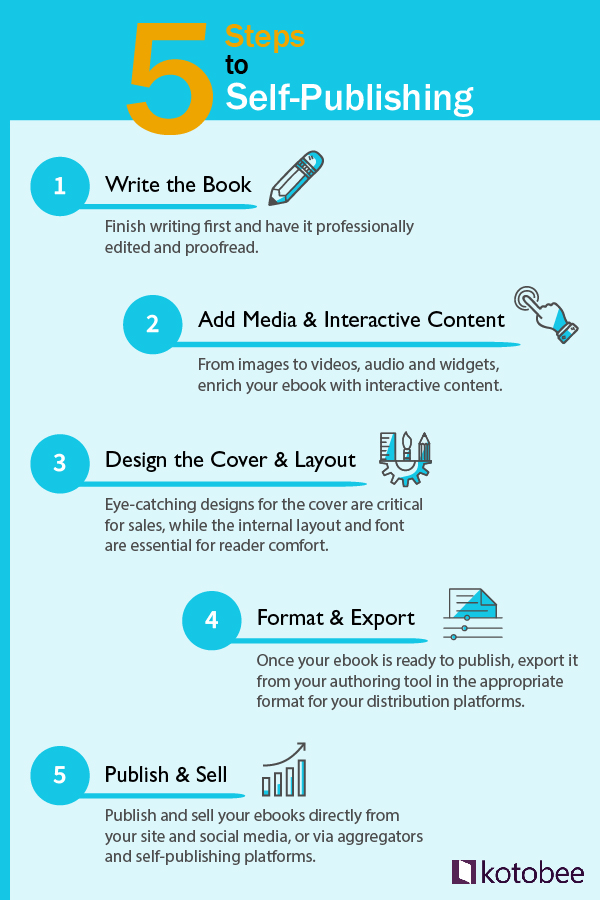Your Guide on How to Self Publish a Book in 2025
If you’re an aspiring author in modern times, then you might have heard a lot about self-publishing. You might have even read dozens of blog articles and watched lots of videos explaining the process. However, the world of self-publishing tends to be complicated and confusing no matter how much you study it.
We know the feeling all too well. For that reason, we’ve done some additional research and compiled all the essential information you need to get started with self-publishing. With this guide, you’ll finally know how to self publish a book and then use that knowledge to share your book with the world.

Photo from Freepik
What Is Self-Publishing?
Self-publishing is a publishing method where you take full responsibility for every step of the process. This includes editing, designing, formatting, and marketing your book. You can choose to handle these tasks yourself or hire professionals to assist you with some of them.
Why do Writers Self-Publish Their Books?
Traditional publishing has historically been the only option for authors who wanted to succeed in the industry. However, that’s no longer the case today. With self-publishing platforms growing more popular and sophisticated every day, even traditionally published authors have started switching to this new path.
Below are a few compelling reasons why self-publishing has become such an appealing route for many authors:
- High profit margin: Self-publishing your book allows you to earn more royalties than you would if you chose the traditional route. That’s because most traditional publishers pay no more than 15% in royalties. On the other hand, self-published authors can earn anywhere from 35% to 90% or more. By self-publishing with platforms like Kotobee Books, you keep all of your royalties!
- Shorter publishing timeline: On average, the traditional publishing process takes anywhere from a few months to two or three years. But with self-publishing, you can decide how long it will take your book to reach the shelves. You can even publish it immediately if you want to.
- Complete control over the process: Publishers usually handle book editing, design, and marketing. As a self-publisher, you would be expected to do all of these tasks yourself or hire others to do them for you. This means you can receive the cover you dreamed of or try creative marketing campaigns that a traditional publisher might see as too risky to invest in.
- Retention of all the rights to your book: After you sign a contract with a publisher, you lose many important rights related to your book, such as distribution, foreign, or audiobook rights. However, you retain 100% of the rights to your book if you choose to self-publish. This means you have complete legal freedom to decide on the formats you want to publish your book in and the platforms or locations to distribute it.
- More accessible to authors worldwide: Self-publishing has opened the door for authors from all backgrounds to enter the market. Previously, you had to get your work accepted by a reputable publisher if you wanted to achieve any success. Nowadays, with the right strategy, you can turn your book into an international bestseller no matter where you live.

Photo from Depositphotos
How to Start Self-Publishing Your Book in 5 Steps
So what does it take to publish your book on your own? Each step takes time and careful planning, from writing the book all the way to publishing it. However, there are only five major steps you need to take to prepare your book before getting it published. Let’s go over each of them now.
1. Write the Book
To start off, you’ll naturally need a fully written manuscript. You’ll need to revise it as thoroughly as you can before sending it to an editor so you can reduce editing costs.
If you find yourself coming across many hurdles in the writing process, then reach out to others for help. There are plenty of writing groups, workshops, courses, and other resources that can help you finish your book.
Important Read: 12 of the Best Book Writing Software to Try in 2024 (Free and Paid)
2. Add Media and Interactive Content
If you were planning to distribute your ebook as a PDF, consider using other formats, such as EPUB or ebook apps, that will allow for adding interactive content. Adding elements such as videos, animations, and mini-apps can engage and captivate your readers.
Here are a few types of multimedia and interactive widgets that you can add to your book:
- Images, videos, and audio clips.
- Widgets such as questions, quizzes, pop-ups, and maps.
- Mini apps and games such as crosswords, sudoku, and chess.
3. Edit Your Book Thoroughly
When you work on a manuscript for a long time, it will get more difficult to spot mistakes. Because of this, the best way to make your work more polished, professional, and ready to be published is by using a professional editor.
While it may seem that editors merely correct your grammar, punctuation, and spelling mistakes, their job goes much further than that. They look at your book from the point of view of your readers and advise you on which parts of your book need further development, organization, and style. While proofreading tools are definitely valuable, you still need someone who can suggest alterations that will fit your book.You can find professional editors on sites like Servicescape, Reedsy, and Scribendi.

Photo from Depositphotos
4. Design the Cover and Layout of the Book
Besides your blurb and title, your book’s cover helps you attract more readers. By the same token, the interior design of your book is also very important as a good one will make the reading experience more comfortable and engaging. In other words, design and formatting is a very important factor for your book’s success.
Whether you take care of the design phase yourself or hire someone else to do so, you’re looking at two main steps:
- Your book cover: The cover of your book is your future readers’ first point of contact with your book. Your cover should be appropriate for your genre and audience as well as convey the basic idea of your book.
- The interior layout of your book: While it may look simple on the surface, designing the interior of your book can actually take some thinking and planning. For starters, you must choose between a fixed or reflowable layout. That choice alone can take some time to make because it affects the format of your book as well as the publishing platforms you end up choosing.
5. Format and Export the Book
Once you have an edited manuscript, the next step is to format and export it. Ultimately, two factors will determine the ebook formats you need: your chosen publishing platforms, and whether or not you’re planning on including any interactive content.
If you need to, you can easily convert your ebook file from one format to another in a pinch. To do this, you can use book formatting software that can export your manuscript in several different formats, such as Kotobee Author.

How to Publish and Sell Your Book?
Now that you’ve spent a lot of time lovingly preparing your book for the world to read, it’s time to publish it! To help you with this process, we’ll explain the three ways that you can self-publish online. You can choose any of them depending on your preferences and whether or not you want your book in physical libraries.
1. Direct Sales
Direct sales means selling your book directly to your readers from your own platform, such as your website. With this method, you retain 100% of your royalties and only pay any relevant fees for keeping up your website.
For simple distribution that you can do on your own, you can sell your ebook directly from your blog or website. If you have a WordPress Blog, you can use tools like the Gumroad widget or WooCommerce plugin to make this possible. These plugins enable transaction functionality, as WordPress doesn’t include built-in selling options. Once you install one of those widgets, you can set up a payment gateway, such as Paypal, to process payments. Another way to sell your book to readers directly is by exporting your ebook as a desktop, web, or mobile app. Your ebook mobile apps can then be published and sold on platforms like the Apple App Store or the Google Play Store. With an ebook app, you have more creative freedom to include interactive elements in your book without worrying about platform support.
2. Self-Publishing Platforms & Online Retailers
Self-publishing platforms are online platforms that allow you to publish your book through them in exchange for a portion of your royalties. They help distribute your ebooks and don’t require an agent, unlike traditional publishers. You can contact them directly after having formatted and converted your ebook as per their specified requirements. There are plenty of platforms to choose from today, so here is a comparison of the top self-publishing websites.

3. Aggregators
If you find coordinating and communicating with multiple retailers a hassle, we recommend looking into aggregators. They will help you distribute your ebooks via different online retailers and even library distributors. The latter point is one of the advantages in an aggregator’s favor because no other self-publishing platform will distribute to libraries at a profit.
The best part about aggregators is that they consolidate all your sales and profits into one report, instead of forcing you to check several sites. But as helpful as they are, aggregators also take a cut of your royalties, so make sure you read the terms and conditions carefully.
In order to distribute your book through aggregators or sell it in libraries and physical stores, then you should obtain an ISBN (International Standard Book Number). Aggregators need an ISBN to ensure that they properly catalog and distribute your book while also increasing its visibility and credibility. In the US, you can obtain your ISBN from Bowker, whereas other countries have their own official agencies for ISBN registration.
If you want to go with the aggregator route, you can use platforms such as the Indie Author Project to distribute self-published ebooks to public libraries.

Photo from Depositphotos
How to Market and Promote Your Book?
The final step of the self-publishing process is marketing your book. This phase is crucial to the book’s success as it will be the main tool you use to attract readers. In fact, many authors agree that you should start marketing your book before you publish it!
As effective as it is, book marketing can be a long and tiring process. So, we recommend that you start with the following steps first to make the best use of your time and budget:
- Build an author website: Your author website can be as simple as a collection of web pages about you and your book. But no matter how simple you make it, you should seriously consider investing in one even if you’re on a tight budget. A well-made website will make you look more professional as an author.
- Create an author mailing list: Your author newsletter will be your most important long-term marketing tool. Besides talking about your book, you can also give your email subscribers exclusive benefits, such as reader magnets, that can help convert new readers into fans.
- Plan a book launch event: A book launch can help spread the word about your book and drive your book sales on the first day of its launch. They’re expensive to plan and set up, but the investment is worth it.
- Make social media profiles and use paid ads: Most authors today have an online presence on social media platforms. This is because these channels make it much easier to reach and connect with new readers and audiences. In addition to posting on social media for free, you can also use paid ads, giveaways, and other strategies to effectively market your book to a wider audience.
- Ask for book reviews: You can go to websites such as NetGalley or Edelweiss to get bloggers to read and review your book. Alternatively, you can find bloggers or readers who would give you a free book review on websites like Goodreads, Pixel of Ink, Inspired Reads, or Kindle Reader.
Final Thoughts
As a first-time author, you might be nervous about self-publishing your book. But as long as you know exactly how to go about it, you can achieve great success with your book. So bookmark this article and start preparing your work for your future readers!
.
Read More
Exploring the Best Ebook Platforms in 2025
Book Royalties: What They Are and How to Earn the Best Rates
How to Publish a Book for Free and Maximize Your Profit
















Shirley Coulter Ericson
May 1, 2023Can you give any insight into Newman Springs? It is a hybrid company that has been around for 6 years. I am considering them but feel wary.
Kotobee
December 27, 2023Hi Shirley!
While considering Newman Springs, it’s good to be cautious. Look into their reputation, review terms carefully, and seek feedback from authors who’ve worked with them. Your comfort and confidence are key.
Best of luck with your decision! 🙂
Rivkah Lapidus
November 15, 2023Can you give me any insight on AMZPros? They are not (they say) affiliated with Amazon. My book is now up on Amazon in hardback, soft bound and Kindle. My book contains illustrations. I did layout, and proofread the proofreaders. I think they might be hybrid, and I definitely declined their marketing services. It took many reformatting. I have been wary the whole time, but did have a team to work with. I own the ISBN. When they published the version that was badly edited, they came down on price so that I could republish it.
Kotobee
December 27, 2023Hey Rivkah!
It’s great that your book is up on Amazon! Regarding AMZPros, just be cautious. Understand the agreement terms and make sure the quality is top-notch. Chat with fellow authors or seek advice to ensure everything’s smooth sailing.
Best of luck with your book! 📚✨
Sofia
August 15, 2025Super helpful and down-to-earth! I love how you break down every step—from writing to marketing—in a clear, no-fluff way. Perfect for aspiring authors.